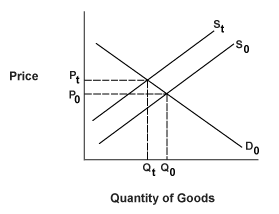Tariffs
Tariffs are taxes imposed on imported goods; they will increase the price of the good in the domestic market. Domestic producers benefit because they receive higher prices. The government benefits by collecting tax revenues. In the graph below, S0 and D0 represent the original supply and demand curves which intersect at (P0, Q0). St shows what the supply curve is with the introduction of the tariff. The market then clears at (Pt, Qt). Less of the good is produced, and consumers pay higher prices.
Quotas Quotas are numerical limits imposed on imported goods. Consumers are harmed by quotas, while domestic and foreign producers benefit by receiving higher prices. In the graph below, the market initially clears at P0, Q0. The supply curve Sd+i0 represents the quantity supplied by both domestic and foreign producers before the imposition of the quota. D0 is the domestic demand curve. After the quota, the supply curve looks like Sd+i1. Both foreign and domestic producers receive higher prices while consumers lose out.
Voluntary Export Restraints (VERs) These restraints limit the quantity of goods that can be exported from the country to one or more of its trading partners. They are usually "voluntarily" negotiated so that quotas or tariffs are not imposed. Exchange Rate Controls Exchange rate controls set the exchange rate of a nation's currency above the market rate. This makes the nation's exports artificially expensive, which reduces the quantities of the nation's goods that foreigners are willing to buy. This means that the country's citizens have little foreign currency available to buy imported goods. With exchange rate controls, black markets usually exist where currency exchange occurs at a market rate. Exchange rate controls are declining in popularity, although some developing nations still use them."Hidden" Methods Hidden methods of limiting imports include special regulations and licensing requirements that restrict imports. For instance, the Japanese government imposes special quality requirements on food to restrict food imports and protect Japanese farmers.
Figure 5.5: Effect of a Tariff on a Supply Curve
Quotas Quotas are numerical limits imposed on imported goods. Consumers are harmed by quotas, while domestic and foreign producers benefit by receiving higher prices. In the graph below, the market initially clears at P0, Q0. The supply curve Sd+i0 represents the quantity supplied by both domestic and foreign producers before the imposition of the quota. D0 is the domestic demand curve. After the quota, the supply curve looks like Sd+i1. Both foreign and domestic producers receive higher prices while consumers lose out.
Voluntary Export Restraints (VERs) These restraints limit the quantity of goods that can be exported from the country to one or more of its trading partners. They are usually "voluntarily" negotiated so that quotas or tariffs are not imposed. Exchange Rate Controls Exchange rate controls set the exchange rate of a nation's currency above the market rate. This makes the nation's exports artificially expensive, which reduces the quantities of the nation's goods that foreigners are willing to buy. This means that the country's citizens have little foreign currency available to buy imported goods. With exchange rate controls, black markets usually exist where currency exchange occurs at a market rate. Exchange rate controls are declining in popularity, although some developing nations still use them."Hidden" Methods Hidden methods of limiting imports include special regulations and licensing requirements that restrict imports. For instance, the Japanese government imposes special quality requirements on food to restrict food imports and protect Japanese farmers.
Figure 5.5: Effect of a Tariff on a Supply Curve
 |
Figure 5.6: Effect of Quotas on the Supply Curve
 |






0 comments:
Post a Comment